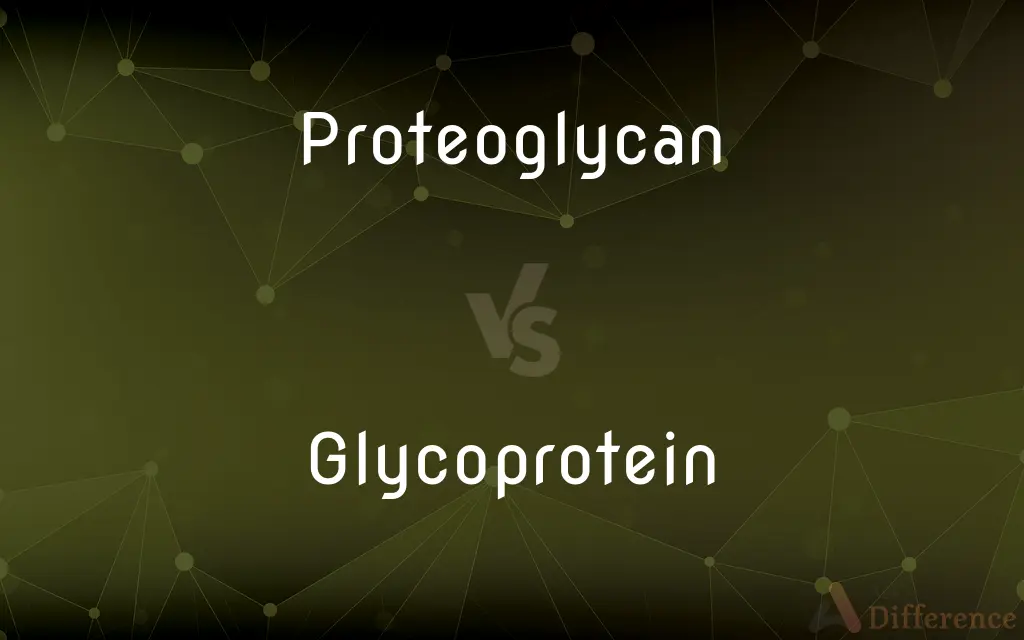Proteoglycan vs. Glycoprotein — What's the Difference?
By Urooj Arif & Fiza Rafique — Updated on April 18, 2024
Proteoglycans are proteins heavily modified with glycosaminoglycans, primarily structural in nature, while glycoproteins have shorter carbohydrate chains and are more diverse in function.

Difference Between Proteoglycan and Glycoprotein
Table of Contents
ADVERTISEMENT
Key Differences
Proteoglycans are characterized by their large glycosaminoglycan (GAG) chains, which are covalently attached and dominate their structure, making them key components in connective tissues. Glycoproteins, however, have shorter and more varied carbohydrate chains attached to the polypeptide chain, influencing functions ranging from cell-cell recognition to immune responses.
Proteoglycans primarily contribute to the structure of the extracellular matrix, providing rigidity and resistance to compression in cartilage and other tissues. Glycoproteins play crucial roles in cellular functions such as hormone activity, immune function, and as membrane receptors.
Proteoglycans are mainly found in the extracellular matrix of connective tissues, like cartilage and skin. Glycoproteins are ubiquitous, found on cell surfaces, in bodily fluids, and within cells, participating in nearly every biological process.
The extended GAG chains of proteoglycans can bind a large amount of water, which is essential for tissue hydration and resilience. Glycoproteins often interact specifically with other molecules through their carbohydrate chains, facilitating precise biological interactions.
Both are vital for organismal health; defects in proteoglycan synthesis can lead to skeletal disorders, while abnormalities in glycoprotein functions are linked to diseases like muscular dystrophy and various immune disorders.
ADVERTISEMENT
Research into proteoglycans often focuses on their role in tissue engineering and regenerative medicine, given their structural properties. Glycoprotein studies are integral to understanding disease mechanisms, especially in cancer and autoimmune diseases.
Comparison Chart
Carbohydrate Chains
Long glycosaminoglycan chains
Short, diverse carbohydrate chains
Primary Function
Structural support in tissues
Diverse, including signaling and immunity
Location
Mostly in extracellular matrix
Cell surfaces, bodily fluids, intracellular
Water Binding
High due to GAG chains
Lower compared to proteoglycans
Clinical Impact
Skeletal disorders, tissue repair
Immune disorders, cancer, signaling diseases
Compare with Definitions
Proteoglycan
A compound consisting of a protein bonded to glycosaminoglycan groups.
Proteoglycans in the cartilage help it retain water and resist compressive forces.
Glycoprotein
Proteins that contain oligosaccharide chains covalently attached.
Glycoproteins on the surface of cells help in immune recognition and cell adhesion.
Proteoglycan
Primarily found in the extracellular matrix.
The abundance of proteoglycans gives the skin its resilience and firmness.
Glycoprotein
Found in all body fluids and cellular compartments.
Glycoproteins in saliva play a role in the initial digestion of carbohydrates.
Proteoglycan
Plays a crucial role in cell signaling and tissue repair.
Proteoglycans in the wound matrix help in the healing process by organizing the tissue structure.
Glycoprotein
Involved in numerous biological processes, including immunity.
Antibodies are glycoproteins that play a pivotal role in the immune response.
Proteoglycan
Associated with load-bearing.
The knee joint relies on proteoglycans to buffer the forces exerted during running.
Glycoprotein
Acts as receptors and structural components of cells.
Glycoproteins in the cell membrane function as receptors for hormones and other signals.
Proteoglycan
Linked with hydration of tissues.
Proteoglycans can absorb and retain substantial amounts of water, which is vital for tissue hydration.
Glycoprotein
Can be targeted for therapeutic interventions.
Some cancer treatments involve targeting specific glycoproteins on tumor cells.
Proteoglycan
Proteoglycans are proteins that are heavily glycosylated. The basic proteoglycan unit consists of a "core protein" with one or more covalently attached glycosaminoglycan (GAG) chain(s).
Glycoprotein
Glycoproteins are proteins which contain oligosaccharide chains (glycans) covalently attached to amino acid side-chains. The carbohydrate is attached to the protein in a cotranslational or posttranslational modification.
Proteoglycan
Any of various glycoproteins that have glycosaminoglycan chains attached by covalent bonds to the protein, usually found in the extracellular matrix of connective tissue.
Glycoprotein
Any of a class of proteins which have carbohydrate groups attached to the polypeptide chain.
Proteoglycan
(biochemistry) Any of many glycoproteins that have heteropolysaccharide side chains
Glycoprotein
Any of a group of conjugated proteins having a carbohydrate as the nonprotein component.
Glycoprotein
(protein) A protein with covalently bonded carbohydrates.
Glycoprotein
A conjugated protein having a carbohydrate component
Common Curiosities
What roles do glycoproteins play in the body?
Glycoproteins are involved in diverse functions including signaling, immune response, and cell adhesion.
Are glycoproteins involved in disease processes?
Yes, abnormalities in glycoprotein functions are associated with diseases such as cancer, muscular dystrophy, and immune disorders.
What distinguishes a proteoglycan from a glycoprotein?
Proteoglycans have long glycosaminoglycan chains, whereas glycoproteins feature shorter and more varied carbohydrate chains.
Where are proteoglycans mainly found?
Proteoglycans are primarily located in the extracellular matrix of connective tissues.
How do proteoglycans contribute to tissue properties?
Proteoglycans provide structural support and maintain hydration and resilience in tissues.
Are glycoproteins customizable for drug delivery?
Yes, glycoproteins can be engineered to deliver drugs specifically to targeted cells or tissues.
How do proteoglycans differ from glycoproteins in their carbohydrate content?
Proteoglycans have a higher carbohydrate content relative to their protein part than glycoproteins.
What is the significance of glycoproteins in immune responses?
Glycoproteins function as antigens and receptors, playing critical roles in the immune system's ability to recognize and respond to pathogens.
What makes glycoproteins essential for cell structure?
Glycoproteins contribute to the structural integrity and function of cell membranes.
Can proteoglycans absorb water?
Yes, the glycosaminoglycan chains in proteoglycans enable them to absorb and retain a significant amount of water.
How are proteoglycans used in medical research?
Proteoglycans are studied for their potential in tissue engineering and regenerative medicine due to their structural properties.
How do glycoproteins affect cell communication?
Glycoproteins act as cell surface receptors that mediate communication between cells and their external environment.
Why are proteoglycans important for joint health?
They buffer compressive forces in joints, crucial for movement and load-bearing activities.
What clinical disorders are associated with proteoglycans?
Disorders related to proteoglycans include various skeletal dysplasias and cartilage-related diseases.
What are some examples of glycoproteins and their functions?
Examples include erythropoietin, which stimulates red blood cell production, and fibrinogen, a key factor in blood clotting.
Share Your Discovery

Previous Comparison
Appearance vs. Reality
Next Comparison
Eldest vs. OldestAuthor Spotlight
Written by
Urooj ArifUrooj is a skilled content writer at Ask Difference, known for her exceptional ability to simplify complex topics into engaging and informative content. With a passion for research and a flair for clear, concise writing, she consistently delivers articles that resonate with our diverse audience.
Co-written by
Fiza RafiqueFiza Rafique is a skilled content writer at AskDifference.com, where she meticulously refines and enhances written pieces. Drawing from her vast editorial expertise, Fiza ensures clarity, accuracy, and precision in every article. Passionate about language, she continually seeks to elevate the quality of content for readers worldwide.














































